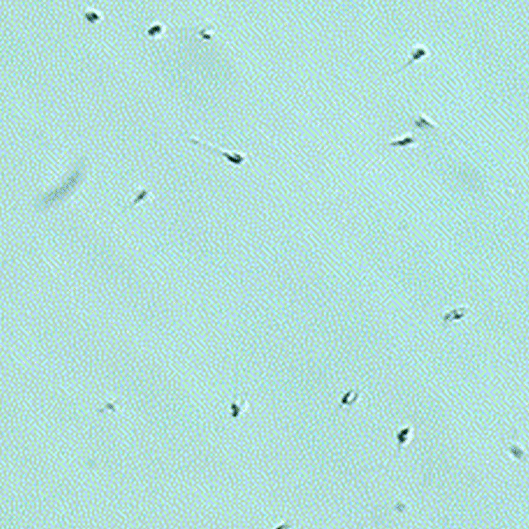This was published 1 year ago
‘Spermageddon’: Behind the headlines of the great Western fertility furore
A scientific study suggesting human sperm counts are plummeting across the Western world has generated global headlines and much hand-wringing. But fear not: male fertility is not over yet.
By Tim Elliott

Good moving sperm ready for insemination seen under a microscope. Research suggesting sperm counts are plummeting went viral and became known as “spermaggedon”.Credit: IVF Australia
In 2017, an 81-year-old American scientist named Professor Shanna Swan, from the Icahn School of Medicine at Mount Sinai in New York City, published a study which suggested that human sperm counts had dropped by more than half in the past 40 years, and that our species was, as a result, hurtling toward an imminent reproductive crisis. The paper, which was co-authored by Hagai Levine of Hebrew University, among others, was the largest ever study of human sperm counts: a meta-analysis of 185 papers and 42,935 men that claimed to show that total sperm count had declined by 59.3 per cent between 1973 and 2011, at about one per cent a year. A follow-up paper in 2022 was even more alarming, suggesting that the decline had accelerated markedly since 2000.
Scientists are usually known for their circumspection, but Swan was unambiguous about the implications. In interviews with journalists, she suggested that by 2045, men’s median sperm count could be zero, and that, as a consequence, most babies might have to be conceived using artificial means. The decline was nothing short of a “global existential crisis”, she wrote in her 2021 book, Count Down: How Our Modern World Is Threatening Sperm Counts, Altering Male and Female Reproductive Development and Imperilling the Future of the Human Race. “The current state of reproductive affairs can’t continue much longer without threatening human survival.”
The story soon went viral. Newspapers described Swan’s findings as “spermaggedon” and “sperm-pocalypse”. Swan, meanwhile, became a star. She appeared on Joe Rogan’s podcast and was interviewed by Russell Brand. In 2022, she headlined a live science event at the Koncerthuset, in Copenhagen, where the announcer introduced her as “The one and only Shanna. F---ing. Swan!”
In her book, Swan mostly blamed the sperm decline on a range of widely used chemicals, including bisphenols and phthalates, which appear in many plastics, including food containers and baby bottles, and which interfere with the body’s production of the hormones testosterone and oestrogen.
But, of course, everyone had a theory of their own. It was feminism, porn, tight underwear, soy milk. It was veganism or COVID or COVID vaccines or political correctness or climate change. In today’s politically disordered landscape, “spermageddon” was embraced with equal gusto by people who otherwise wouldn’t want to breathe the same oxygen, from environmentalists, who wanted to end plastics and Big Ag, to culture warriors and men’s rights groups, who wanted to end gender pronouns and marriage equality. By the time doubts about “spermageddon” began to surface, the story had assumed a life of its own, spawning narratives every bit as intriguing as anything Shanna Swan had written.

US professor Shanna Swan declared humanity was facing a “global existential crisis” following her research into sperm counts.
Men are pretty fond of their sperm. It’s unique to them, and it makes humans. It also does a lot of heavy lifting, culturally speaking, as a stand-in for masculinity, vitality, and what has been imagined through the ages to be men’s earth-shaking powers of procreation, a cosmic life force capable of bringing into being not just gods and mortals but, in some cases, whole worlds. In Greek mythology, sperm from Uranus’ severed testicles is spilled into the sea, where it gives birth to Aphrodite (no egg required). The ancient Sumerian god, Enki, was so terrifyingly virile that when he masturbated, his semen created the Tigris and the Euphrates Rivers.
Meanwhile, in the 21st century, sperm is increasingly being seen as a biomarker of men’s health. “It can indicate bigger health problems,” says Moira O’Bryan, dean of the faculty of science at the University of Melbourne and a professor of reproductive biology who, with a team of leading international scientists, produced a paper in October urging greater awareness of men’s fertility. “We know definitively from animal models that when animals have even a mild illness that their sperm count drops. And we have very compelling data that if a man has an infection, say from COVID, or even if he has a broken arm, his sperm count will drop.”
Quantitative semen analysis has been going on since 1929, but the first comprehensive study came in 1992 when a team led by Danish scientist Elizabeth Carlsen produced research suggesting that sperm counts had plummeted by 60 per cent between 1938 and 1990. The study was criticised for poor methodology and bias; subsequent papers found either a much lower decline in sperm count, no change or even a slight increase. In 2021, a paper written by three specialists, including Dolores J. Lamb, a professor of molecular biology in urology at the Weill Cornell Medicine College, described Carlsen’s conclusions as “patently false”.
Nonetheless, Carlsen et al’s paper caught on. One of the researchers to be influenced by it was Shanna Swan, who was then working for the California Department of Health. Swan began conducting similar work with a focus on the effects of pollutants on male fertility. A 2003 study in semi-rural Missouri found it likely that exposure to pesticides was damaging men’s sperm. In 2014, she and a team of researchers began working on a far larger study that ultimately became the 2017 “spermageddon” paper.
The paper, which was published in Human Reproduction Update, attracted controversy from the get-go. For one thing, Swan divided her findings into two categories: “Western” and “Other”. “Western” included men from North America, Europe, Australia and New Zealand – white-majority areas. The “Other” category included Africa, South America and Asia – that is, mainly black and brown populations. The distinction, which seemed inherently racialised, became more problematic when it emerged that Swan had only observed a significant sperm count decline in “Western” men. On the face of it, African, Asian and Latin American sperm was fine.
Swan attributed the discrepancy to a dearth of data from non-Western countries. Nevertheless, her findings were uncritically adopted by men’s rights activists and ethno-nationalists, who used them to validate their narrative of white male victimhood, and especially the dangerous and increasingly pervasive Great Replacement theory, whereby white men are being supplanted by hordes of hyper fertile black immigrants. Counter-Currents, a prominent white nationalist journal, called Swan’s book “gripping reading for those concerned about the future of the white race in the West”.
Meanwhile, in the dungeons of social media, alt-right warriors stewed over bubbling cauldrons of misogyny and race hate. The decline of Western sperm might be caused by fatty foods and smoking, but the real culprits were more likely to be “niggers”, Jews, affirmative action (“It’s what happens when leadership positions are given to women just because they’re women,” one man wrote on Reddit), and even hair dye (“Return to a more traditional American society where the men are honourable and chivalrous, not assholes that dye their hair blue … and sperm counts will triple within the year,” wrote another). But when it came to the great white spermicide, all roads led to feminism. “When did feminism really start to take over pop culture?” someone called Billee_Boyee wrote on Reddit. “The ’70s. Where? Europe, North America, Australia and New Zealand. Where is feminism not really a thing? South America, Asia and Africa.”
Providing cover for the white-power movement wasn’t, presumably, on Swan’s agenda. (Swan did not reply to multiple requests for an interview.) But her research was feeding into an environment where ideas of masculinity were already highly politicised, where conservatives mocked liberals for eating too much tofu, and a presidential candidate, namely Donald Trump, felt the need to go on daytime TV’s The Dr Oz Show in 2016 and have his testosterone count publicly revealed. (“Your testosterone is 441 – which is, actually … is good,” Oz said, to whoops from the audience.)
In 2022, conservative politics, uber-sperm and dangerous quackery inevitably converged in a project by then-Fox News pundit Tucker Carlson. Prompted by accounts of plummeting testosterone, Carlson, who had cited Swan’s work on his program, released a short documentary called The End of Men, an epically (and presumably unintentionally) homoerotic, Riefenstahl-esque tribute to hyper-masculinity, with shots of shirtless men swinging axes and firing machine guns. In one scene, a man stands naked, arms out, Jesus-style, bathing his testicles in infra-red light, an alternative, and widely debunked, “therapy” for boosting testosterone. Shanna Swan described a clip’s claim for the treatment as “very misleading”. But as Carlson made clear, when it came to making American sperm great again, everything should be on the table.

Testicle tanning in Tucker Carlson’s documentary, The End of Men.
Once the initial panic over “spermageddon” plateaued, questions emerged about Swan’s study. Some were predictably partisan. Swan, who had long argued for tighter regulation of the chemical industry, was ridiculed on junkscience.com, a website run by Steven Milloy, a noted climate sceptic and advocate for Big Tobacco and oil companies. (She had been similarly targeted by Jon Entine, a journalist who has written in defence of the agrochemical industry and founder of the educational non-profit Genetic Literacy Project, which has long advocated for the use of GMO foods and pesticides.)
“You can get a sample from one man and … give one half to one lab and the other to another lab, and often you get two markedly different results.”
Andrologist Robert McLachlan
But other criticisms are harder to dismiss. One of the main ones concerns methodology. Swan and her team didn’t perform any original research; it was a meta-analysis, meaning an analysis of previous studies going back to 1973, the reliability of which is difficult to gauge. “Lots of the studies used for Swan’s 2017 analysis don’t contain all the information that is needed,” says andrologist Robert McLachlan, the medical director of Healthy Male (formerly Andrology Australia), a federal government-funded men’s health body. “In some cases, the ages of the men are missing. Almost 45 per cent of the studies she used don’t include the year the sperm sample was collected, and 29 per cent don’t mention the average sperm concentration.” (Where such data was missing, Swan and her team made estimates.)
Technology is also an issue. “Over the decades that these studies were performed, we have no way of knowing how closely the labs adhered to best practice,” McLachlan says. “Even today, you can get a sample from one man and split it in half and give one half to one lab and the other to another lab, and often you get two markedly different results. And not just small differences – several-fold.”
It’s normal for sperm counts to vary seasonally (highest in winter, lowest in summer), from region to region, and according to diet, medication, exercise and stress levels. Abstinence also plays a part: generally speaking, the shorter the time between ejaculations, the lower the sperm count (although, curiously, the better the sperm quality). Controlling for all these factors over a 38-year period would seem almost impossible, especially when analysing studies of significantly different sizes. As several researchers, including the Harvard-based GenderSci Lab, have pointed out, some of the studies that Swan and her team relied on were too small to signify much of anything. One study in 2000 in Mexico included just 48 men, all of whom worked in a rubber factory. “Extrapolating from such a small, select group of men to the general population is inherently problematic,” McLachlan says.
Besides, there were plenty of findings that contradicted Swan’s work. Between 1992 and 2012, there were 35 major papers examining changes in sperm count. Eight of them suggested a decline, and six showed ambiguous or conflicting results. But 21 studies, involving 112,386 men, showed either no change or improvements in semen quality. Needless to say, none of these 21 studies made the news. That Swan’s work has so dominated the narrative says a lot about the way science works in the age of mass media. “Scientists are incentivised to publish work that shows sensational results,” says Tim Moss, health-content manager at Healthy Male. “They have this publish-or-perish professional landscape. You get grant money if you have your work published, and it’s more likely that your work will be published if you can show some effect. For example, if you do a study comparing two groups of people, and you show there is no difference, it’s harder to get that published than if you did a study that shows a big difference.”
There is no suggestion that Swan and her team pursued the sperm decline research simply because they would get headlines; she and others had been involved in the area for many years. But, at a general level, there is no doubt that in today’s attention economy, headlines can help a scientist’s career.
Science helps us make sense of the world. It also helps governments make health policy. But the science we see is only part of the picture. “You pay attention to Fox News, and you’ll get one type of information, and if you listen to the ABC you’ll get another,” says Moss. “It’s exactly the same with science.”
Jordan Jamieson has arguably the most scrutinised pair of testicles in Australia. They have been fondled and photographed, shifted and jiggled, coddled in cotton and elastic mesh. They have had their temperature taken at regular intervals, their comfort minutely calibrated. They have been treated, in other words, like supermodels. But it’s perhaps more useful to think of them as test pilots. “I’m normally a bit quiet and introverted,” he says, when we talk on Zoom. “Prior to all this, I would never have imagined speaking about my balls so much. But you get used to it.”
“There were no testicle-cooling undies on the market, so I thought I’d make my own.”
Jordan Jamieson
Jamieson, who is 40, lives with his wife, Saara, and their two young kids in Brisbane, where he works as a radiographer at Princess Alexandra Hospital. Saara, who is 37, trained as a scientist, and has worked much of her career in cancer research. She and Jordan got married in 2013, and started trying for a baby. “It was hard,” Jordan says. “We went at it for a couple of years, but nothing seemed to happen.”
Saara miscarried in 2015, on her 29th birthday, and then again seven months later. Jordan’s sperm was fine, but he figured some optimisation couldn’t hurt. “I’d heard that heat was bad for sperm,” he says. “But there were no testicle-cooling undies on the market, so I thought I’d make my own.” He bought some cheap underwear and mosquito netting and, with little more than a needle and thread and some imagination, set about designing a prototype. “I just stitched a mesh pouch onto the front of the undies, where you put your balls.” It was ugly and uncomfortable, but he kept going. Saara got involved, and they brought in a pattern-maker. “I’d stand in this woman’s living room in my underwear and explain what we needed to adjust. I fell back into using anatomical terms, which took the awkwardness out of it. I’d say, ‘the testes need more support there,’ not ‘my testes’, or ‘the scrotum feels uncomfortable like that,’ never ‘my scrotum’.”

Jordan Jamieson wearing Cool Beans undies, the end result of DIY testicle-cooling optimisation he conducted while trying for a baby with wife Saara (right).
By early 2016, they had a model that Jordan felt comfortable wearing. In September that year, Saara conceived; the baby, named Van (after Van Morrison), was born in June 2017. (They are careful not to definitively attribute their pregnancy to the underwear.)
By 2018, Jordan and Saara had decided to turn the underwear into a business, which they called Cool Beans. Along the way, Saara has learnt more about balls than any woman should reasonably be expected to know, including average differences in testicle temperature when standing, sitting and walking; the worst professions for sperm health (bakers, ceramic oven operators, truck drivers, welders), and the interaction between testicles and certain fabrics, such as polyester – fibres from which can, according to some studies, interact with scrotal hairs to create an electrostatic field which is much like putting your balls in a little microwave oven.
Also: fat balls. “Obesity is bad for sperm,” she says. “When we put on weight, we don’t just put it on on the body, you also put it on your scrotum. So you have a thicker layer of fat around your testicles. Your thighs also get wider, insulating your testicles, especially when you’re seated. For a male with an average BMI, you only need to sit for 20 minutes for sperm production to stop.“
In 2021, Cool Beans underwear was registered as a medical device in Australia. But comfort is also key. Having tried a pair, I can vouch for their wearability, though they did take some getting used to. For a while, it felt as if something – or someone – was gently cradling my nuts in a gloved hand.
Male infertility is now a $US4 billion ($6.2 billion) market worldwide, according to Grand View Research. Defective testicles have become low-hanging fruit for fertility clinics and supplement companies, which, capitalising on genuine health concerns and an epidemic of male status anxiety, are peddling everything from semen-building vitamins to “herbal teas for dads-to-be”. There are now dozens of take-home sperm-test kits on the market, with names like SwimCount and Ovry. Most are aimed at wannabe dads, but there are also the don’t-wannabe dads, which is to say, guys who want to make sure their vasectomy still works. Some of the tests require that you send a sample to a lab for a precise reading; others are more basic, and only provide a positive or negative result to indicate a normal or low sperm count. The at-home tests work much like a rapid-antigen COVID test kit: you deposit your sample into a jar, dilute it, then use a pipette to squeeze a few drops on a reactive pad. It pays to shop around: I came across one Chinese-made kit that claimed to be “Fast, Convenient, and Raliable”.
Men worried about their declining virility can also freeze their sperm. In the US, companies like Legacy offer product packages that include two semen analyses, one test for sexually transmitted diseases, and eight vials for your sperm that can be put in cryostorage for up to five years. (Price: $US1195 or about $1840.) Some US companies even offer sperm-freezing as an employment benefit.
Does all this really matter? Do sperm counts count? After all, an average man produces perhaps 300 million sperm per ejaculation.
Surgery is also an option, and not just scrotal lipectomy (removal of fat from the scrotum), which has been shown to have positive effects on sperm production, but also for the aforementioned varicoceles which, in extreme cases, can make the scrotum look like a bag of worms, and significantly decrease fertility. Fortunately, semen quality usually improves after surgery, the details of which I’m not going into here since there’s a good chance you’re eating.
Does all this really matter? Do sperm counts count? After all, an average man produces perhaps 300 million sperm per ejaculation, only one of which is needed to fertilise an egg. That seems like a lot of built-in redundancy.
The World Health Organisation defines a low sperm count as anything below 15 million per millilitre of semen. (Most men expel between 1.25-5 millilitres of semen each time they ejaculate, which is a quarter to one teaspoon. Again, apologies if you’re eating.) “But there are many men around the world who have 10 million per millilitre and would have conceived,” says Moira O’Bryan, from the University of Melbourne. “They just would have taken longer.” Besides, male fertility is determined not only by sperm count but by sperm quality which is, in turn, determined by motility (how the sperm swim) and morphology (the shape of the sperm). “Counting sperm is one thing,” O’Bryan says. “But if you produce 100 million sperm per ejaculate, but they can’t swim, then they’re no good.” O’Bryan says there are some studies suggesting that sperm quality is declining worldwide but, as with the research around sperm count, the debate is like an academic rabbit-hole you could fall into, never to emerge.
In any case, some people regard a decrease in human fertility as a good thing. Earth is now home to 8.1 billion people, and we are in the midst of a climate catastrophe. Voluntary childlessness has become popular among young couples. The strongest advocates for population growth tend to be economists, politicians and father of eight Elon Musk, who argue that without more births, there won’t be enough people to build the roads, make the coffees, answer the phones, and take care of all the old people.
Of course, governments are likely to step in before that happens. There will be child-rearing incentives, baby bonuses. (Already many countries, including Japan and Italy, have introduced such payments. Then-federal treasurer Peter Costello introduced a $3000 baby bonus here in the early 2000s.) And if sperm actually does run out, there will surely be alternatives. In 2009, a team of English scientists created early-stage sperm from human embryonic stem cells. In 2016, Japanese researchers impregnated female mice using similar technology. Sperm is, perhaps, not as unique to men as men always thought. Indeed, science fiction, a noted harbinger of imminent reality, has long featured stories of single-sex worlds, of female utopias where men are redundant, figures of ridicule or zoological fascination or simply irrelevant, like parts of a car that has been rendered obsolete. Now that’s what I call status anxiety.
To read more from Good Weekend magazine, visit our page at The Sydney Morning Herald, The Age and Brisbane Times.